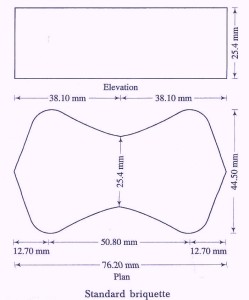Tensile Strength of Cement
Tensile Strength of Cement test was formerly used to have an indirect indication of compressive strength of cement. It is at present generally used for the rapid hardening cement.
Tensile Strength of Cement Test Procedure:
(i) The mortar of cement and sand is prepared. The proportion is 1:3 which means that (x) gm of cement is mixed with 3(x) gm of sand.
(ii) The water is added to the mortar. The quantity of water is 5 per cent by weight of cement and sand.
(iii) The mortar is placed in briquette moulds. A typical briquette is shown in below figure. The mould is filled with mortar and then a small heap of mortar is formed at its top. It is beaten down by a standard spatula till water appears on the surface. Same procedure is repeated for the other face of briquette. Such twelve standard briquettes are prepared. The quantity of cement may be 600 ml for 12 briquettes.
(iv) The briquettes are kept in a damp cabin for 24 hours.
(v) The briquettes are carefully removed from the moulds and they are submerged in clean water for curing.
(vi) The briquettes are tested in testing machine at the end of 3 days and 7 days. Six briquettes are tested in each test and average is found out. During the test, the load is to be applied uniformly at the rate of 35 kg/cm2 or 3.50 N/mm2.
(vii) It may be noted that cross-sectional area of briquette at its least section is 6.45 cm2. Hence the ultimate tensile stress of cement paste is obtained from the following relation:
Ultimate tensile stress = failing load / 6.45
viii) The tensile stress at the end of 3 days should not be less than 20 kg/cm2 or 2 N/mm2 and that at the end of 7 days should not be less than 25 kg/cm2 or 2.50 N/mm2.

